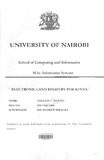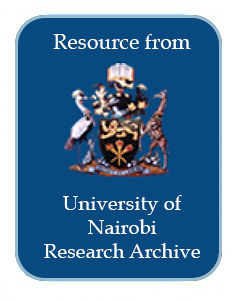Location
Our Vision is to be a world-class university committed to scholarly excellence.
Our Mission is to provide quality university education and training and to embody the aspirations of the Kenyan people and the global community through creation, preservation, integration, transmission and utilization of knowledge.
Core Values
In order to realize the above vision and mission, certain shared values shall be nurtured. There is great need for the University to be guided by the right values derived from the virtues and moral standards of the Kenyan and wider society.
Core Functions
Teaching and Learning: The university offers innovative , relevant and market driven academic programmes , both at undergraduate and postgraduate levels with inbuilt quality control systems the university also provides an environment and policy framework for undertaking high quality and relevant research
Members:
Resources
Displaying 131 - 135 of 298Electronic Land Registry for Kenya
Land in most Kenyan societies is the most important of the natural resources, representing
the foundation of much of the country's economic activity. For most individual Kenyans,
the purchase of a parcel of land represents the largest financial and legal transaction of their
lifetime. Hence the buying, selling, and refinancing of land is a significant component of the
Kenyan economy. Therefore the. ability to firmly and quickly establish ownership and to
allow secure and effective transfers is essential to the economic competitiveness of Kenya in
Land cover and use changes in the rangelands of Central-Uganda: Impacts on soil quality and pasture productivit
This study determined the patterns and magnitudes of land cover
and use changes, their driving factors and impacts on soil quality
and pasture productivity in Nakasongola district. Satellite data
(1970 - 2009), surveys, soil and pasture sampling techniques
were used. Woody and bare encroachments are major changes
affecting soil quality and pasture productivity. Changes in fire
regimes, poor stocking densities, termites, climatic variability
and tree cutting are major drivers of the land cover and use
The challenges of rehabilitating denuded patches of a semi-arid environment in Kenya
Land degradation is a major problem in the semi-arid environments of Sub-Saharan Africa. Fighting land degradation is essential to ensure the sustainable and long-term productivity of the habited semiarid lands. In Kenya, grass reseeding technology has been used to combat land degradation. However, despite the use of locally adapted perennial grass species namely Cenchrus ciliaris (African foxtail grass), Eragrostis superba (Maasai love grass) and Enteropogon macrostachyus (Bush rye) failure still
Impacts of management and enclosure age on recovery of the herbaceous rangeland vegetation in semi-arid Kenya
Establishment of seasonal grazing enclosures has become an important rangeland rehabilitation strategy in semi-arid regions. This study assessed the impact of enclosure age and enclosure management on the vegetation composition in the Njemps Flats range unit, Lake Baringo Basin (Kenya). Six communal enclosures (13–23 years since establishment) and six private enclosures (3–17 years since establishment) were selected.




